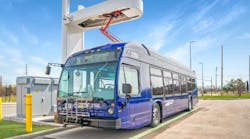Combined investment of C$1.3 million to help TransLink plan transition to zero-emission bus fleet by 2040
The government of Canada, TransLink and the Canadian Urban Transit Research & Innovation Consortium (CUTRIC), are making a combined investment of C$1.3 million (US$967,076) for TransLink to plan the transition of its bus fleet to zero emission vehicles by 2040.
Through the investment, TransLink is developing a comprehensive strategy, including a detailed market scan of current and emerging zero-emission technologies and a transition roadmap, which will include a zero-emission bus (ZEB) implementation action plan and deployment strategy, an investment roadmap, and recommendations for future ZEB innovation projects.
“Clean public transit connects Canadians to their communities and helps achieve our target of net-zero by 2050. We are proud to work with TransLink to help commuters get where they need to go while transitioning their fleet to reduce their carbon footprint,” said Harjit S. Sajjan, minister of international development and minister responsible for the Pacific Economic Development Agency of Canada.
The government of Canada is contributing C$1 million (US$744,455) to the project through the Zero Emission Transit Fund (ZETF). TransLink is contributing C$260,000 (US$193,584). The ZETF helps communities transition to zero-emission transit and school buses to reduce greenhouse gas emissions and contribute to Canada’s net-zero emissions targets.
This fund is closely coordinated with the Canada Infrastructure Bank's (CIB) Zero Emission Bus Initiative, through which the CIB has committed more than C$1.5 billion (US$1.14 billion) to supporting the deployment of zero-emission buses.
“TransLink is taking serious action to address climate change by planning for a zero-emissions fleet by 2040. This important partnership will help that ambition to become reality. Those who use transit for their commute are taking one of the biggest steps they can to reduce their own carbon footprint,” said Kevin Quinn, CEO, TransLink .
CUTRIC has been supporting Canadian municipalities with their fleet transition. The consortium’s mission is to support the commercialization of technologies through industry-led collaborative research, development, demonstration, and integration projects that bring innovative design to Canada’s low-carbon smart mobility ecosystem.
The government of Canada notes around 55 percent of the passenger miles travelled on TransLink’s system are zero-emission, thanks to Metro Vancouver’s electrified SkyTrain network and North America’s second-largest trolley-electric bus fleet
“In the pursuit of sustainable mobility, transitioning Canada’s public transportation fleets to low carbon options is of the utmost importance. Through supporting TransLink in developing a transition plan to zero-emissions vehicles, we are collectively catalyzing a cleaner, greener future for Canada. Embracing zero-emission vehicles is our commitment to reducing our carbon footprint and inspiring a nationwide shift towards eco-friendly transportation. We are proud to be working toward this goal with TransLink, through the government of Canada’s continued support, ultimately pioneering a sustainable legacy for generations to come,” said Josipa Petrunić, president and CEO, CUTRIC.




